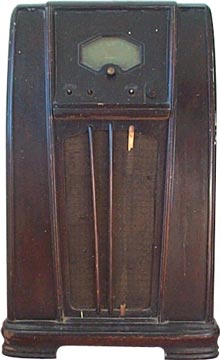
Canadian Westinghouse 813
ca. 1936-37

The second of two consoles bought from a collector in Dorchester, New Brunswick, Feb.15, 2001. (See also the CGE A-87) It's missing a 12" speaker, as well as one of the bars on the speaker grille. At some point, it looks like, someone gave it a coat of shellac but didn't do a very good job of it. There are drips on the dial cover, on one of the knobs (the one that appears to be original), and on the brass labels for the power switch and band selector switch.
| Tube Complement | |
| 1st Det. | 6L7 |
| Osc. | 6J7 (mine was missing) |
| I.F. | 6K7 |
| 2nd Det. and AVC | 6H6 |
| Audio | 6F5 |
| Output | 6F6 |
| Tuning "Eye" Tube |
6E5 (mine had 6U5 installed) |
| Rectifier | 5W4 (mine had 5Y3GT installed) |
|
Frequencies |
|
| I.F. | 460 kHz |
| SW | 5.5 - 18 MHz (dial range) |
| MW | 1750 - 5500 kHz (dial range) |
| BC | 530 - 1740 kHz (dial range) |
NostalgiaAir has the RCC 1936/37 Series service data sheets available online:
Schematic Data Sheet Westinghouse-37 for Westinghouse 813a, 813x, and 813y. (includes 176kB image, 300 dpi)
Alignment Data Sheet Westinghouse-33 for Westinghouse 512A, 512X, 512Y, 513A, 513X, an 513Y. (includes 212kB image, 300 dpi)
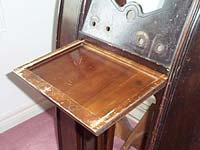 This
pull-out shelf would not come out until I removed the chassis. Somebody
had used round-headed screws on the shelf that supports the chassis, and
the heads of the screws jammed the shelf below. You can see where they
scraped the top of the shelf on either side. This
pull-out shelf would not come out until I removed the chassis. Somebody
had used round-headed screws on the shelf that supports the chassis, and
the heads of the screws jammed the shelf below. You can see where they
scraped the top of the shelf on either side. |
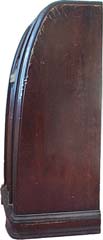 Right
side view Right
side view |

|
These are the control labels that got covered in shellac. Some scrubbing with cotton applicators dipped in isopropyl alcohol brought out this much. I'm not sure what "SP" and "MU" stand for. "Speaker" and "Mute"? It will be nice that I don't have to worry about replacing decals if I end up stripping the finish off |
 |
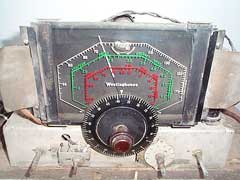 The
dial face is reverse-painted glass, which looked great once I wiped the
dust off. I haven't powered it up yet, but I suspect that the glass is edge-lit
by the two pilot lamps, which should give a neon effect for the graphics.
Note also the 6U5 tuning eye tube at the top. The
dial face is reverse-painted glass, which looked great once I wiped the
dust off. I haven't powered it up yet, but I suspect that the glass is edge-lit
by the two pilot lamps, which should give a neon effect for the graphics.
Note also the 6U5 tuning eye tube at the top. |
This knob looks like it might be one of the originals, except for the custom paint job. The other one was just a modern replacement. The tuning knobs should be a concentric set, with outer ring for coarse tuning, the inner knob for fine tuning. There are Philco repro knobs that look vaguely similar. Know anybody that has more of these? |
I started to get most of the shellac drips off the plastic dial cover, using "Goof-Off". Once I realised that alcohol might take it off quicker, I thought I'd try that. Having already learned from bitter experience, I tested it first on the edge. Sure enough, the plastic itself started getting sticky, so I canceled that plan.
I also gave it a once-over with "Murphy's Oil Soap", but all I got off was the dust. I'm pretty sure I'll end up having to strip it right down to the wood. Whittling a new bar for the speaker grille is going to be interesting too.
May 8 & 9, 2001
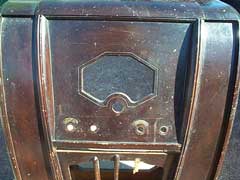 |
Finally, some sunshine and warm weather, so I dragged the cabinet out into the driveway. This shot is from before I started working on it. Even in direct sunlight, any grain in the veneer is totally obscured by the shellac. I went at it with a jug of methyl hydrate and a wad of #0000 steel wool, an old toothbrush, and a 1 1/2" plastic spatula. I did this outdoors because of the fumes, which are more dangerous than isopropyl and other alcohols. I rather expected that the shellaq would come off, exposing a coat of factory-applied nitrocellulose lacquer, which should not be affected by the methyl hydrate. |
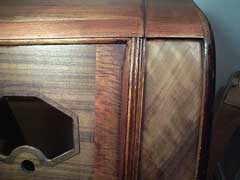 |
Whatever was there, it came off with the shellac sludge, even if I rubbed it very gently. This makes me wonder if the original finish wasn't also shellac, or perhaps ther was a sealer coat of shellac under lacquer, causing the lacquer to lift off with it. Lo and behold! - some patterns appear. The different colours of veneer make me believe there was a tint in the original finish. I couldn't tell if there was any selective colouring, such as extra-dark toner lacquer on the vertical trim pieces. |
 |
There's buried treasure everywhere! This was a complete surprise, found just above the slot for the pull-out shelf. |
Later that week: Too bad - It's been raining the last few days, so I have to wait before I continue the stripping. I was able to buy a small piece of maple for the grille.
Next week: I learned that disposable latex or vinyl gloves are not at all good for use with any kind of stripper or refinishing solvent. Now I use nitrile gloves, and a dish-washing type scrub brush so that I don't spend any time with my hands submerged in the solvent.
June 5, 2001 - I've been contacted by Chris W. King, of Mississauga, Ontario, who has worked on two Westinghouse consoles with cabinet designs similar to the model 813 – a model 512 and a model 823.
July 29, 2001 - Still waiting for some grain filler paste to arrive before I work on the cabinet, and for a variac before I work on the chassis.
Back to John Rose's Vintage Radio Home